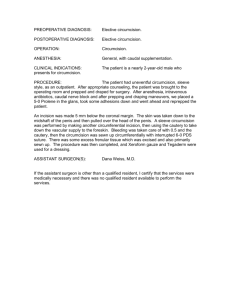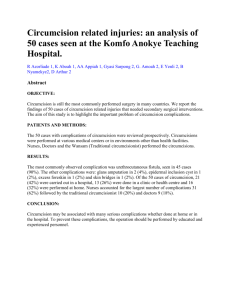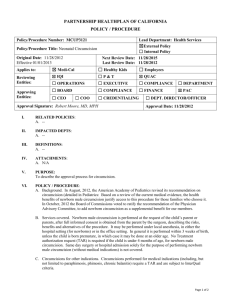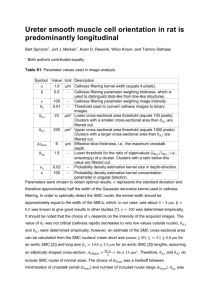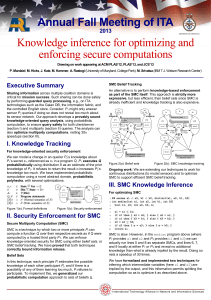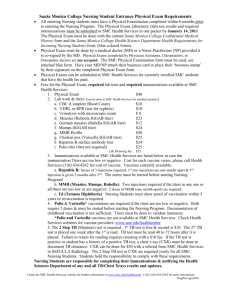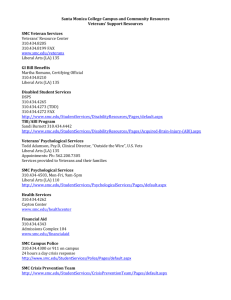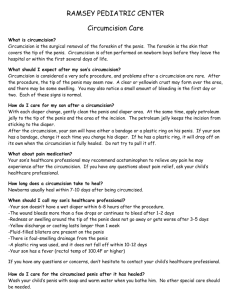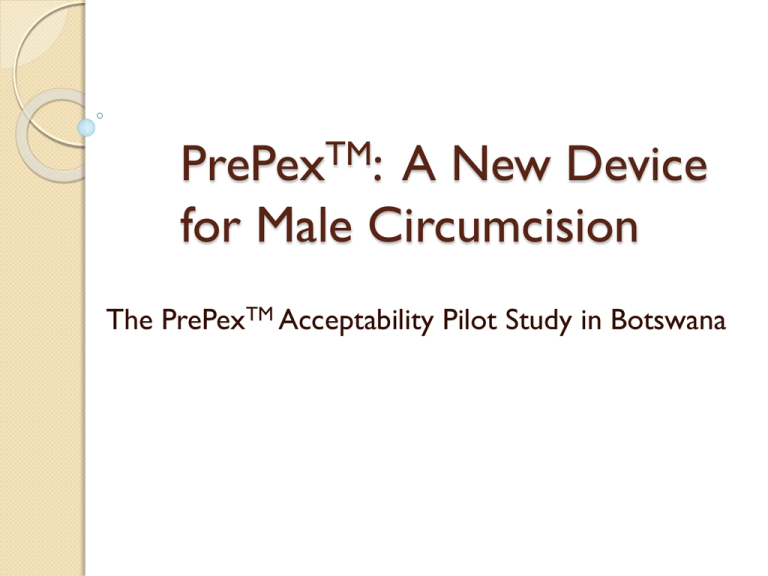
TM
PrePex :
A New Device
for Male Circumcision
The PrePexTM Acceptability Pilot Study in Botswana
Presentation Outline
Background
Key program limitation
What is PrePexTM device and procedure
Research on PrePexTM device in other countries
The Botswana PrePexTM study: Goals and objectives
Ethical approvals of the study
Study design
Management of study
Inclusion criteria
Implications of Iitroducing PrePexTM pilot study to the SMC
program
Contacts for more information
Background
Male circumcision devices have potential to
accelerate program scale up, and raise the
circumcision uptake.
PrePexTM is a new adult device for Male
circumcision that has been researched in other
African countries. Results indicate that
circumcision with this device is:
• Faster, bloodless, no injection for anaesthesia, no stitches
• Require less time off work for men
• Procedure can be conducted by nurses in simple settings
Current SMC modalities and outputs
Space
Personnel
Equipment
Demand
Program targets and achievement
Program target is 385,000 MCs by 2016
Present achievement is much lower than target
- approximately 30% of target for 2012
Key program challenges
Low demand for services. Some barriers identified
include
• Fear of pain
• Time
• Time off work
• Six week duration of abstinence
Human resources to ensure wider coverage
Shortage of space for SMC services in small health
units
What is PrePexTM device?
Delivery Ring
Inner Ring
Elastic Ring
The PrePexTM procedure: Day 0
Measurement, Day 0
Device
Placement,
Day 0
Appearance at departure, Day 0
The PrePexTM procedure: Day 7
Appearance on return visit, day 7
Device removal,
day 7
Appearance
at 3 weeks
Appearance
at 6 weeks
PrePexTM device has potential
to bridge program gaps
Low demand for services: Addresses the
identified barriers:
Fear of pain
Time
Time off work
Six week duration of abstinence
The human resources to ensure wider service
coverage, and
Space limitations
Known adverse events with the
PrePexTM procedure
All adverse events documented to date have been
mild and resolved completely
Mild Swelling
Mild discomfort 2-3 hours after application
Possible social discomfort
Slight pain or discomfort during removal – pain
lasts less that one minute
Findings from the Rwanda PrePexTM
Studies
PrePexTM device is safe
PrePexTM is safe and easily done by nurses
Men are actively seeking the PrePexTM device for
male circumcision
PrePexTM studies in other countries
Uganda
Rwanda
Hh
Nn
nn
Tanzania
Zimbabwe
Mozambique
South Africa
Lesotho
The PrePexTM study in Botswana
Goal
To evaluate the acceptability and safety of the PrePexTM
device in routine clinical settings among adult males in
Botswana
Objectives
Evaluate training of nurse providers to learn
PrePexTM procedure and use the device in Botswana
Describe and assess client and provider acceptability
Describe and assess safety of the PrePexTM device
when the procedure is performed by nurses
Ethical approvals for the study
The following regulatory boards for research have
approved the study;
HRDC-Ministry of Health, Botswana
Center for Disease Control (CDC ) Institutional
Review Board
Johns Hopkins University Institutional Review Board
Study timelines
Activity
Protocol Development and approvals
Status/ Projected Timeline
Completed
Key Procurements
Almost Completed
Staff recruitments
On-going
Materials Pretesting
Feb 2013
Site team Orientations
Feb 2013
Advocacy meetings
Feb 2013
Staff Training
Feb-Mar 2013
Participant recruitment
Mar 2013
Interim review
May 2013
Study closure
Jul 2013
Analysis and report writing
Aug 2013
Dissemination of Findings
Sept 2013
Study design
PrePex pilot study will be conducted in two
phases:
•
•
Preparatory phase: Training of health providers
Implementation phase: Health providers enrolling
eligible clients for the study and conducting follow ups
Sample size: About 1000 men will be circumcised
during the study
Study will be conducted in two Ministry of
Health clinics: Nkoyaphiri and Block 8
How will the study be managed?
Overall leadership and Coordination by MOH
SMC Partners will support training, procure
supplies provide staff and technical support
The study is expected to last 4-6 months
To take part in the study, one must:
1.
2.
3.
4.
5.
6.
7.
8.
Be an uncircumcised male, aged 18 to 49
Agree to be circumcised using the PrePex method
Be HIV negative
Agree to return to the health care facility for at least 3
scheduled follow-up visits
Accept to provide contact information for study follow up
Agree to complete study surveys and/or interviews in
person on a designated schedule
Be able to communicate in English or Setswana
Agree to abstain from sex or six weeks
What will happen to those who qualify
and agree to take part in this study?
Screening for SMC eligibility
Education on PrePexTM
Consenting
Examination for medical fitness
Administration survey questionnaires
Circumcision with PrePexTM device
Follow up visits (Days 0, 7, 14, 42)
Some men will still be eligible for surgical
circumcision even if they may not qualify for PrePex
What are the implications of introducing
PrePexTM to regular SMC services?
PrePexTM device will not replace the usual
circumcision surgery
• About 10-20% of men are medically not eligible for the
device
• PrePexTM device is currently only available for adults age
18 to 49 years old
What are the implications of introducing
PrePexTM to regular SMC services?
Regular MC will remain available at study clinics,
and nationwide
PrePexTM procedure won’t be offered at least for
some period after the study closes
Eventual program policy on PrePexTM device will
be guided by study findings
What are the expectations
from the SMC program about PrePex?
The PrePexTM device has a potential to dramatically raise
demand for SMC by addressing men’s fears of pain and
loss of time from work, among its other technical
advantages
For more information, contact:
Mr Conrad Ntsuape
Ministry of Health
+267-363-2235
ontsuape@gov.bw
Dr Ali Ali
Ministry of Health
+267-363-2328
alisalum@gmail.com
Dr Adrian Musiige
Jhpiego
+267-318-1166
amusiige@jhpiego.net
Acknowledgements
DCS


